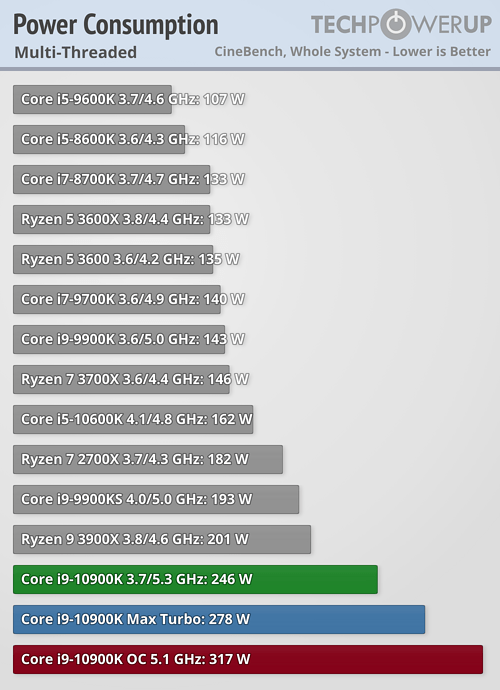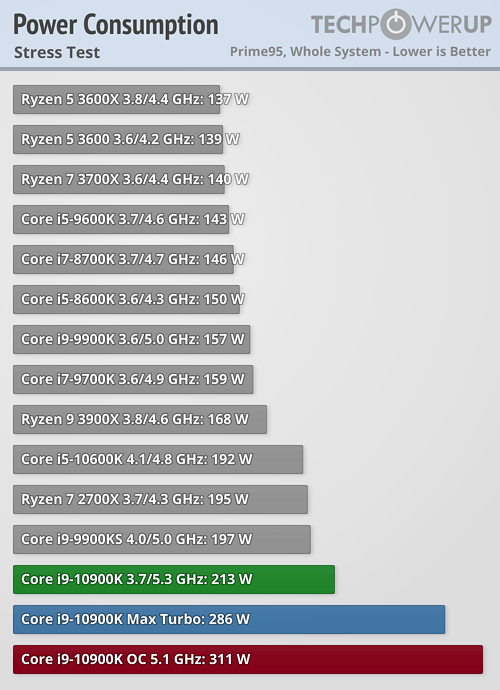 209
209
Intel Core i9-10900K Review - World's Fastest Gaming Processor
Temperatures »Power Consumption
As mentioned before, the Core i9-10900K is subject to several power limits, which is the only way Intel could achieve significant performance improvements while staying within their TDP rating. The test below tries to illustrate the various limits. We run the rendering software Blender while measuring full system power consumption.
As you can see, as soon as the load starts, power consumption shoots up to 310 W. After a few seconds at maximum power, the CPU will throttle the load down to 125 W, so it stays within the processor's TDP rating of 125 W.
Allowing short bursts of activity is perfectly valid because the CPU heatsink has time to cool down while the system is idle, which frees up additional thermal budget for the Boost algorithm to exploit.
This mechanism is called PL1 Tau using EWMA (exponentially weighed moving average). Basically, the CPU measures the time it is idle (or lightly loaded) and allocates an energy budget for boost to exceed the PL1 limit.





Energy Efficiency
In this section, we measure the total amount of energy consumed for a SuperPi run (single-threaded) and Cinebench (multi-threaded). Since a faster processor will complete a given workload quicker, the total amount of energy used might end up less than on a low-powered processor, which might draw less power, but will take longer to finish the test.

Jan 23rd, 2025 13:58 EST
change timezone
Latest GPU Drivers
New Forum Posts
- 12700K vs 245K (14)
- Mouse Suggestions and Recommendations ? (12)
- Ryzen 7600 ram 64gb vs 2 /4 channel,vs higher speed (67)
- Real Performance of the RTX 50 Series (Without DLSS 4, According to Nvidia) (26)
- Feel vibration under left side of laptop keyboard when the left fan is at full speed (5)
- Silent mode bios doesnt work after flashing (5600xt) (14)
- Mobo choice for 12600k after returning MSI Tomahawk ( Broken M2 shield standoff ) (20)
- 3D Vapour chamber in new NVidia RTX 5000 cards - what is it? (29)
- Audio starts crackling, then PC becomes unresponsive (14)
- What do you do for a living? (418)
Popular Reviews
- NVIDIA GeForce RTX 5090 Founders Edition Review - The New Flagship
- NVIDIA GeForce RTX 5090 Founders Edition Unboxing
- NZXT C1500 Review
- NVIDIA GeForce RTX 5090 PCI-Express Scaling
- Alphacool Apex 1 CPU Water Block Review - Performance King!
- Montech Heritage Pro Review - The Leather Case
- Pwnage StormBreaker Max CF Review
- PowerColor Alphyn AH10 Review
- AMD Ryzen 7 9800X3D Review - The Best Gaming Processor
- NVIDIA GeForce RTX 50 Technical Deep Dive
Controversial News Posts
- NVIDIA 2025 International CES Keynote: Liveblog (470)
- AMD Debuts Radeon RX 9070 XT and RX 9070 Powered by RDNA 4, and FSR 4 (349)
- AMD Radeon RX 9070 XT & RX 9070 Custom Models In Stock at European Stores (226)
- NVIDIA GeForce RTX 5090 Features 575 W TDP, RTX 5080 Carries 360 W TDP (217)
- AMD Radeon RX 9070 XT Alleged Benchmark Leaks, Underwhelming Performance (204)
- AMD is Taking Time with Radeon RX 9000 to Optimize Software and FSR 4 (185)
- AMD's Radeon RX 9070 Launch Faces Pricing Hurdles (175)
- Potential RTX 5090 and RTX 5080 Pricing in China Leaks (173)